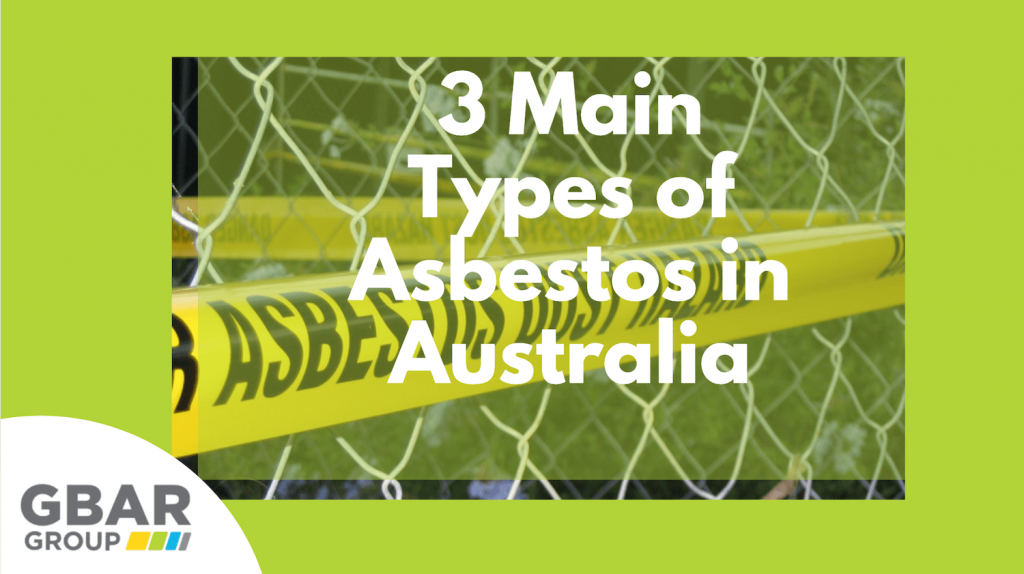
There are six different types of asbestos materials. We look at the 3 most common types of asbestos materials in Australia and how you can identify them and stay safe.
Asbestos is a generic term given to encompass multiple types of different silicate materials. Naturally occurring in the environment, the silicate fibres are all composed of long and thin fibrous crystals that can easily be released into the atmosphere when disturbed. Asbestos is a known carcinogenic; these tiny crystal fibres become a hazard to human health when released into the environment.
Asbestos fibres are between 50 to 200 times thinner than a single human hair and are invisible to the naked eye. The tiny fibres can remain in the atmosphere for a very long time and can easily be breathed into the lungs where they become lodged indefinitely.
Historically, asbestos has been heavily utilised in the industrial, manufacturing and construction industries. The nature of asbestos fibres makes for exceptional malleable and insulation quality materials and products. Asbestos was once considered a very useful material due to its strength, durability, flexibility, affordability, and its properties that resist from high temperatures and chemicals. Before the dangers of asbestos were known, it was commonly used in the construction of homes and buildings.
Asbestos in Australia – A Complicated History
Asbestos has not been used in domestic building materials and products since the 1980s, with the use, importation and selling of asbestos finally being banned Australia wide in December of 2003.
Residential use of asbestos fibres peaked around 1945 to 1960, with asbestos being a large source of filler and mixed in products used in construction. This included being frequently mixed with cement, piping, flooring and tiles to create asbestos-containing materials (non-friable asbestos).
Large amounts of friable asbestos were also used industrially in Australia up until the 1990s. The most common use for friable asbestos in the home was loose asbestos insulation, found in roofing spaces and attics.
There were a number of asbestos mine sites dotted around Australia, abandoned by the 1980s amidst the growing concerns of the health hazards involved.
Today, Australia has one of the largest prevalence of mesothelioma in the world. There are more deaths linked to asbestos exposure in Australia than we can keep up with. The true burden of asbestos-related diseases including lung cancer, mesothelioma and asbestosis, is over 4,000 lives every year.
Australia now faces an epidemic with an increasing demand for asbestos awareness and asbestos removal services. As more people renovate and fix up older homes, more people are being unknowingly exposed to harmful asbestos fibres.
The Different Types of Asbestos
Asbestos refers to six unique minerals – chrysotile, amosite, anthophyllite, tremolite, crocidolite and actinolite – belonging to the serpentine and amphibole families.
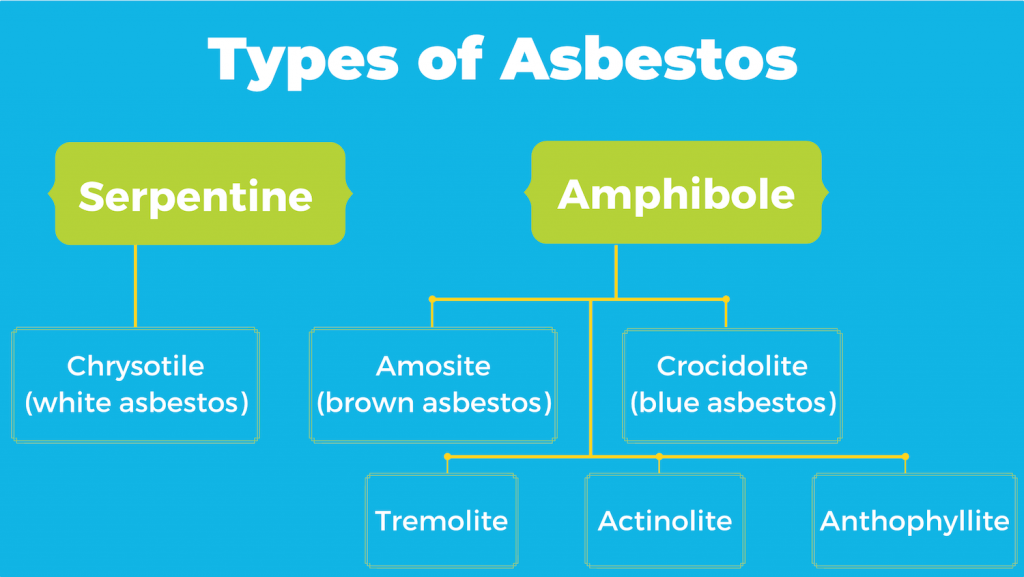
Serpentine minerals have a sheet or layered structure with curly fibres. Chrysotile is the only asbestos mineral in the serpentine group and has historically accounted for more than 95% of all asbestos used around the world. The most commonly found type of asbestos, chrysotile was used in a wide variety of products and materials in Australia.
Amphibole minerals are made up of needle shape fibres that are short, straight, and stiff fibrous crystals. Amosite, crocidolite, tremolite, anthophyllite and actinolite are all members of the amphibole family. Amosite and crocidolite were the most commercially valuable types of amphibole asbestos, while anthophyllite, tremolite and actinolite are considered non-commercial types of asbestos.
Recent studies into asbestos exposure have suggested it takes less exposure from amphibole asbestos to cause cancer, compared to serpentine asbestos. However, all types of asbestos fibres are known to cause health concerns, and there is no ‘safe’ exposure to any asbestos materials, in any type.
The 3 Most Common Types of Asbestos in Australia
Australia’s consumption of asbestos between the 1940s and 1990s contributed to some of the highest in the world per capita. During the peak of asbestos use, the country was mining, manufacturing, importing and exporting copious amounts of asbestos materials.
Although asbestos in Australia was primarily mined in Queensland, New South Wales and Western Australia, its widespread processing, manufacturing, and usage resulted in asbestos being commonly found in all states.
The three most common types of asbestos found in Australia were chrysotile (white asbestos), amosite (brown asbestos) and crocidolite (blue asbestos). These three most common types of asbestos were used in a wide range of applications domestically and industrially.
Asbestos is still widely present in existing materials within buildings in Australia and in particular those building built/renovated prior to 1990. Today, the Australian government has estimated that approximately one-third of all Australian homes contain asbestos in some type or another.
1. Chrysotile Asbestos
Chrysotile asbestos is obtained from serpentine rocks, which are relatively common in the natural environment throughout the world. Under the microscope, chrysotile asbestos appears as tiny white fibres that are curled on the end.
Chrysotile has been used more than any type of asbestos for both domestic and industrial application. The white fibres are extremely flexible and can easily be spun or woven into other fabrics or materials. Chrysotile is also heat resistant and is an excellent thermal, electrical and acoustic insulator.
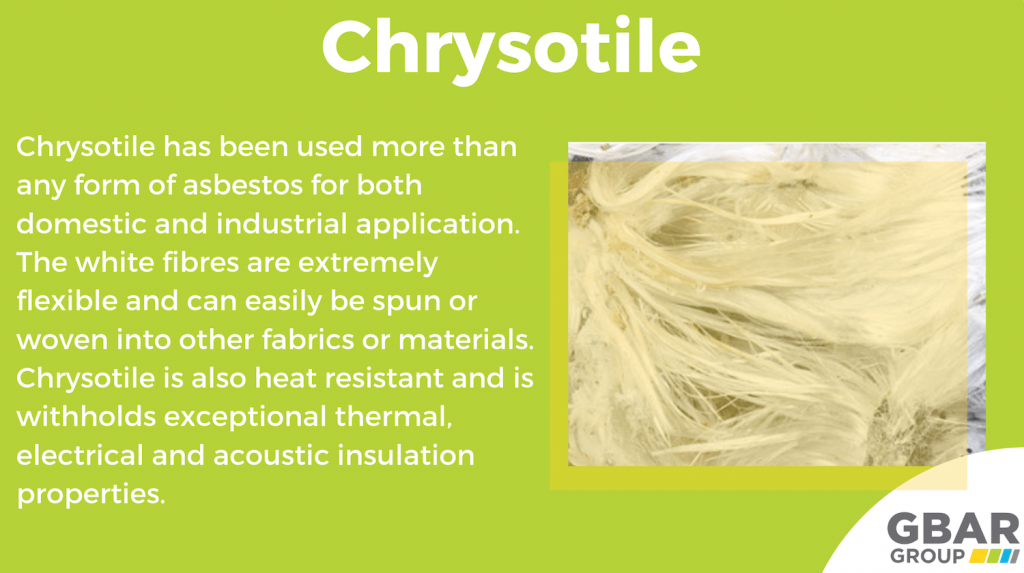
Uses of Chrysotile Asbestos
The most common use of chrysotile asbestos was corrugated asbestos cement sheeting. Chrysotile asbestos fibres mix in well with cement materials and carry their properties over to the finished product. For this very reason, chrysotile is the most common culprit within asbestos-containing products that were once manufactured and used throughout Australia. These include:
- Cement products
- Brake Pads
- Adhesives
- Drywall
- Insulation
- Fireproofing
- Roofing
- Vinyl Tiles
- Gaskets
- Shingles
2. Amosite Asbestos
Amosite asbestos was the second most commonly used asbestos material in Australia. Commonly known as brown asbestos, the texture of amosite fibres is characterised by their sharp, brittle, needle-like fibres and brownish-grey colour.
Amosite was commonly mined in South Africa in its natural type, Grunerite. This type of asbestos is particularly strong and heat resistant, as well as possessing extreme insulation properties. The small needle-like fibres can easily be inhaled and become lodged in the lungs, making amosite one of the most hazardous types of asbestos.
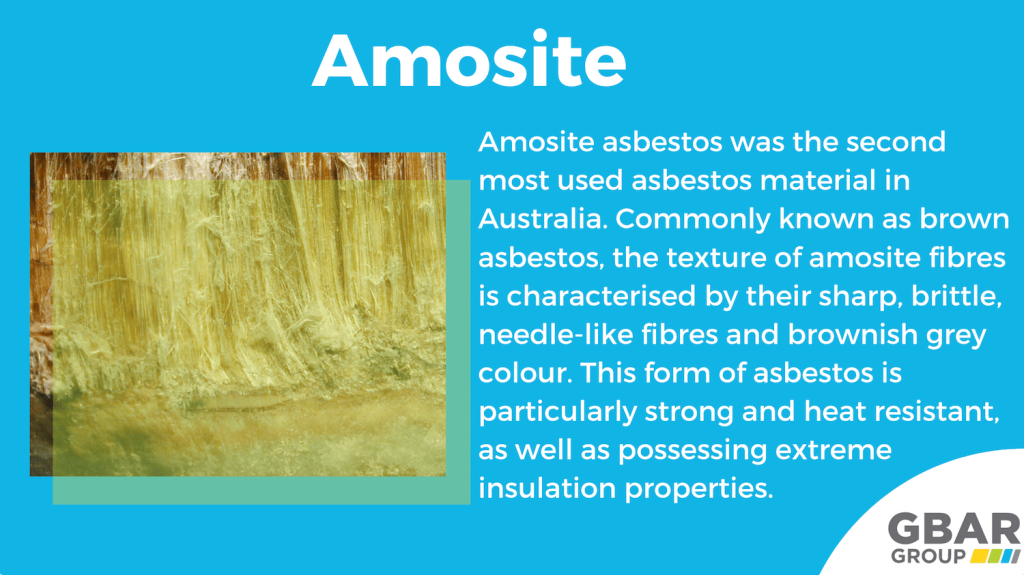
Uses of Amosite Asbestos
Like chrysotile, amosite fibres make great fillers for other materials. This way, the fibres can be bound in and the finished product can benefit from the amosite qualities. This was common practice for a lot of asbestos-cement products in construction. Other amosite asbestos containing products include:
- Fire Protection
- Gaskets
- Insulation
- Cement Sheets
- Roofing Materials
- Vinyl Tiles
3. Crocidolite Asbestos
Crocidolite, commonly known as blue asbestos, is recognized as the most dangerous type of asbestos. Amphibole class asbestos types are classified as having straight, needle-like fibres that differ from chrysotile’s curly ended fibres. These straighter fibres are easier to be inhaled, making them more dangerous.
Crocidolite is naturally used in bundles of long, sharp fibres, that are naturally blue in both natural and processed types. Mined throughout Australia, Africa, and Bolivia, crocidolite commonly occurs as soft friable fibres. The material of crocidolite has extremely high-temperature resistance and is also resistant to strong acids.
While the mineral was the third most used asbestos type in Australia, crocidolite is responsible for more asbestos exposure-related deaths than any other type. It was withdrawn from use much earlier than other types of asbestos.
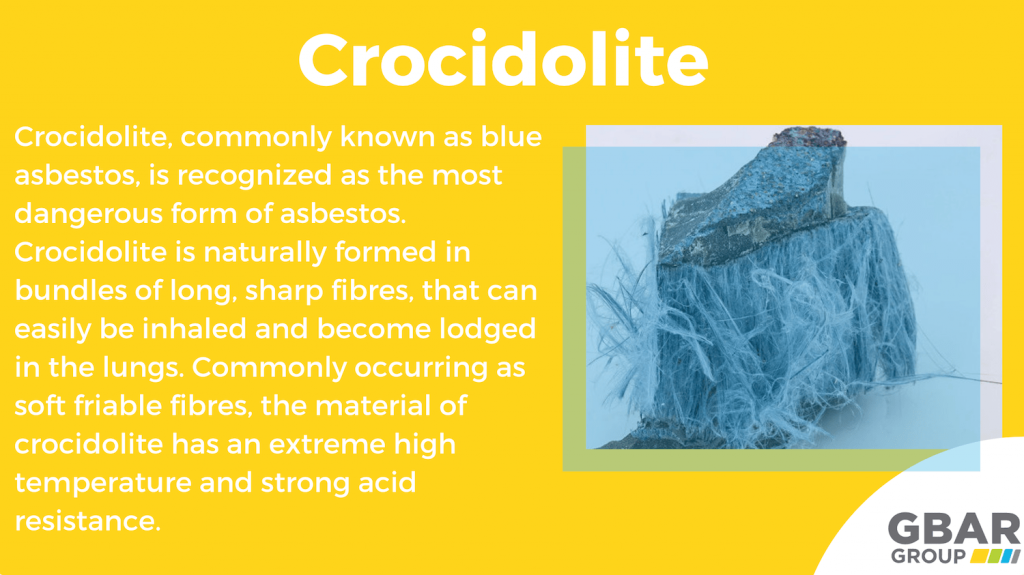
Uses of Crocidolite Asbestos
Originally, crocidolite was preferred alongside chrysotile for industrial use in Australia. It could be found in pipe insulation, thermal insulation, and rope lagging, particularly in industrial facilities. However, the deadly effects linked to crocidolite exposure were quickly exposed and the use of crocidolite decreased.
Crocidolite was rarely used in commercial products because it was found to be less heat resistant than other types of asbestos. Prior to the ban in 1967, it was still used for a number of years, just not at the same rate as chrysotile and amosite. Some common uses for crocidolite were:
- Ceiling Tiles
- Cement Sheets
- Insulation
- Fireproofing
- Acid Storage Battery Casings
The most crippling Australia has with crocidolite is the now declared contaminated site of Wittenoom. In the 1930s, blue asbestos was discovered in Wittenoom Gorge, Western Australia. The town was then set up to accommodate one of Australia’s largest asbestos mines, where over time it slowly turned into one of the most contaminated sites in the southern hemisphere.
The Wittenoom mine was responsible for exporting more than 150,000 tonnes of asbestos between 1943 and 1966. Wittenoom was finally shut down in 1966 when the growing health concerns for the town were starting to outweigh the profit margins of the mining industry.
By then, it was too little too late. More than 2,000 workers and residents of Wittenoom have died from asbestos-related diseases and studies suggest at least 25% of the people who worked in the mine will eventually die of mesothelioma or another asbestos-related disease.
Wrapping Up
Almost twenty years after a complete ban on asbestos being implemented in Australia, protecting Australians from the hazards of asbestos exposure is becoming increasingly complicated.
If you suspect your property contains one of the three main types of asbestos, get in contact to have your property properly surveyed by one of our experts today. The risks associated with asbestos exposure are far too great to not rely on a professional.
The team at GBAR Group are qualified, highly skilled and are very professional asbestos removal experts operating in Brisbane, Sydney and Wollongong. Above all, GBAR Group is committed to providing safety to others and their homes.






